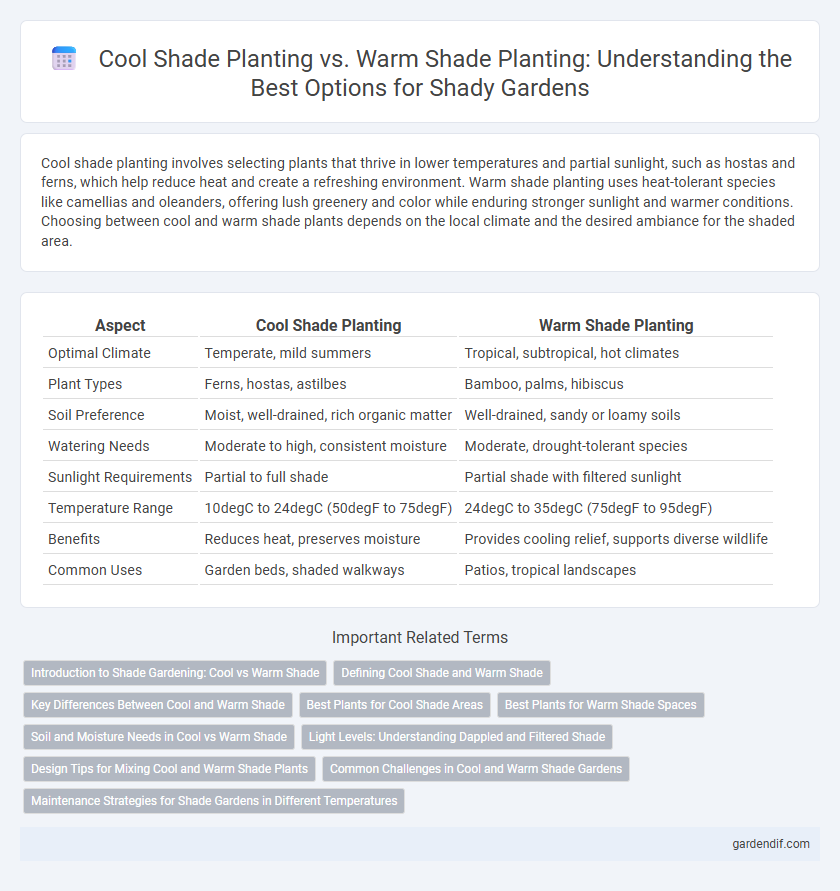
Cool Shade Planting vs Warm Shade Planting Illustration
Cool shade planting involves selecting plants that thrive in lower temperatures and partial sunlight, such as hostas and ferns, which help reduce heat and create a refreshing environment. Warm shade planting uses heat-tolerant species like camellias and oleanders, offering lush greenery and color while enduring stronger sunlight and warmer conditions. Choosing between cool and warm shade plants depends on the local climate and the desired ambiance for the shaded area.
Table of Comparison
| Aspect | Cool Shade Planting | Warm Shade Planting |
|---|---|---|
| Optimal Climate | Temperate, mild summers | Tropical, subtropical, hot climates |
| Plant Types | Ferns, hostas, astilbes | Bamboo, palms, hibiscus |
| Soil Preference | Moist, well-drained, rich organic matter | Well-drained, sandy or loamy soils |
| Watering Needs | Moderate to high, consistent moisture | Moderate, drought-tolerant species |
| Sunlight Requirements | Partial to full shade | Partial shade with filtered sunlight |
| Temperature Range | 10degC to 24degC (50degF to 75degF) | 24degC to 35degC (75degF to 95degF) |
| Benefits | Reduces heat, preserves moisture | Provides cooling relief, supports diverse wildlife |
| Common Uses | Garden beds, shaded walkways | Patios, tropical landscapes |
Introduction to Shade Gardening: Cool vs Warm Shade
Cool shade planting thrives in areas with indirect sunlight and cooler temperatures, favoring plants like hostas, ferns, and astilbes that prefer moist, shaded environments. Warm shade planting suits regions with filtered sunlight and warmer conditions, supporting heat-tolerant species such as cast iron plants, crotons, and caladiums that thrive under dappled light. Understanding the distinction between cool and warm shade guides gardeners in selecting appropriate plants to create vibrant, healthy shade gardens.
Defining Cool Shade and Warm Shade
Cool shade refers to areas shaded by trees or structures that block intense sunlight while allowing cooler air circulation, resulting in a comfortable, lower-temperature environment ideal for plants requiring less heat. Warm shade typically occurs under dense, broad-leaf canopies that filter sunlight but maintain higher humidity and warmth, favoring plants adapted to mild temperatures with indirect light conditions. Understanding the specific temperature, humidity, and light levels associated with cool and warm shade is crucial for effective shade planting and optimized plant growth.
Key Differences Between Cool and Warm Shade
Cool shade planting thrives in lower temperature environments with plants like ferns, hostas, and astilbes that prefer consistently moist, shaded areas and cooler soil. Warm shade planting suits higher temperature zones, utilizing drought-tolerant plants like bougainvillea, hibiscus, and lantanas that withstand direct sun exposure and less frequent watering. Key differences include temperature preference, moisture requirements, and plant species adapted to cool versus warm shaded environments.
Best Plants for Cool Shade Areas
Best plants for cool shade areas include hostas, ferns, and astilbes, which thrive in low-light and moist conditions. These shade-tolerant species exhibit vibrant foliage and delicate blooms, enhancing garden biodiversity while requiring minimal sunlight. Cool shade planting supports soil moisture retention and provides a flourishing environment for shade-loving perennials and groundcovers.
Best Plants for Warm Shade Spaces
For warm shade spaces, selecting heat-tolerant plants like ferns, hostas, and caladiums ensures lush, vibrant growth despite limited direct sunlight. These plants thrive in humid, warm environments and are well-suited for shaded patios or garden corners where temperatures remain elevated but sunlight is filtered. Incorporating warm shade-specific plants enhances garden aesthetics and promotes healthy foliage in challenging light conditions.
Soil and Moisture Needs in Cool vs Warm Shade
Cool shade planting requires soil with high organic matter and consistent moisture to support shade-tolerant plants like ferns and hostas, which thrive in damp, well-drained environments. Warm shade planting demands soil that drains quickly and retains moderate moisture, benefiting species like hibiscus and crotons that prefer drier conditions and less humidity. Understanding these distinct soil and moisture needs ensures optimal growth and health for plants adapted to cool or warm shaded environments.
Light Levels: Understanding Dappled and Filtered Shade
Cool shade planting thrives under dappled shade where light levels are moderate and evenly dispersed, promoting lush, green foliage and slower evaporation rates. Warm shade planting benefits from filtered shade that allows more direct sunlight through gaps, supporting heat-tolerant plants with higher photosynthesis rates. Understanding these light variations enhances plant selection, ensuring optimal growth and energy efficiency in garden design.
Design Tips for Mixing Cool and Warm Shade Plants
Combining cool shade plants like hostas and ferns with warm shade plants such as begonias and coleus creates visual interest and year-round appeal by balancing foliage textures and colors. Position cool shade plants in areas receiving morning sun to preserve their vibrant hues, while placing warm shade plants where filtered afternoon light enhances their growth and color intensity. Utilizing layered planting techniques and varying plant heights ensures a seamless transition between cool and warm shade zones, optimizing both aesthetic harmony and plant health.
Common Challenges in Cool and Warm Shade Gardens
Cool shade planting often faces challenges related to moisture retention and slower soil warming, leading to delayed plant growth and increased risk of fungal diseases. Warm shade gardens frequently struggle with excessive heat stress and rapid soil drying, which can cause plant dehydration and nutrient deficiencies. Both environments require careful plant selection and soil management to mitigate these issues and promote healthy, resilient shade gardens.
Maintenance Strategies for Shade Gardens in Different Temperatures
Cool shade planting thrives with moisture-loving plants like ferns and hostas, requiring regular watering and mulching to maintain soil humidity and prevent drought stress. Warm shade planting favors drought-tolerant species such as succulents and certain palms, emphasizing deep but infrequent watering and well-draining soil to avoid root rot. Adjusting fertilization schedules and monitoring for temperature-specific pests enhances garden resilience and promotes healthy growth in both cool and warm shade environments.
Cool Shade Planting vs Warm Shade Planting Infographic

 gardendif.com
gardendif.com